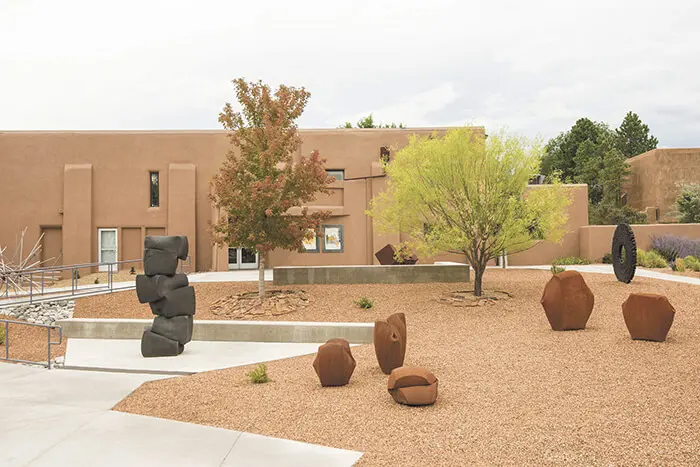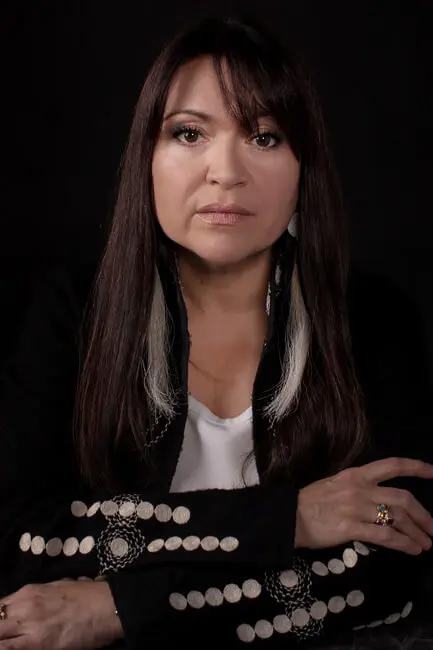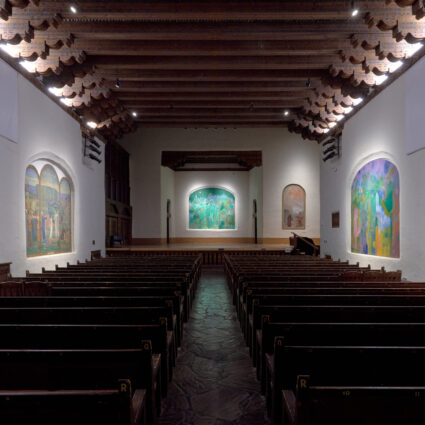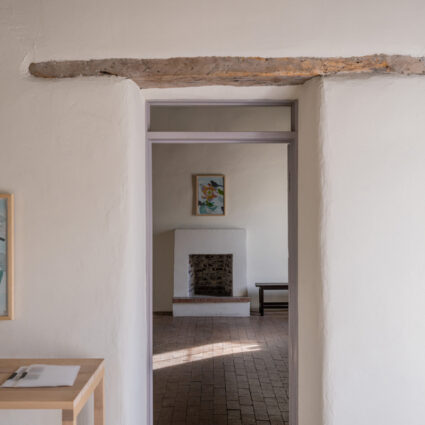Center for Contemporary Arts Santa Fe, which recently announced permanent closure after forty-four years, has reversed course and plans to partially reopen in the city’s shaky arts nonprofit landscape.

ALBUQUERQUE—Last week, following an emergency fundraising effort, the Center for Contemporary Arts Santa Fe said that they’ll reopen the cinema portion of its multi-pronged operation. At the time of writing, CCA’s two-screen movie house is tentatively scheduled to show films once again starting Wednesday, May 3, 2023.
The announcement came a little under two weeks after the forty-four-year-old arts institution, which also houses a large gallery space with robust and ambitious programming, made the abrupt and dramatic proclamation that they were shuttering for good. Executive director Danyelle Means (Oglala Lakota), part of a fourteen-person full- and part-time team, lost her job in the process.
Now that at least part of CCA has perhaps been saved—buoyed by more than $200,000 in pledged cash via a donation campaign piloted by a CCA board member—a laid-off CCA employee calls the reopening plan a bait-and-switch.
“I’m sure the public thinks, ‘Oh, no. This organization that we love is closing. Oh, look. Somebody is trying to do something about it. Let’s pitch in.’ It’s taking advantage of the public by not giving them accurate information,” says April Chalay, a former CCA deputy director who, to date, is the only former CCA employee to speak out. She, like all of her coworkers, lost her job following the April 6 closing announcement.
“CCA has a history of mismanagement. I don’t think it has ever been with evil intentions, but [the mismanagement] has happened so many times,” she says.
Chalay says that two weeks before CCA vowed to close for good, CCA’s board of directors asked high-level staff, including Means and Chalay, to slash $400,000 from a $1.3 million budget that the board had approved approximately five months previous.
CCA board president David Muck, who has heard the bait-and-switch allegation posited in Santa Fe’s gossip circles, refutes the claim of calculated deceit.
“It really was that we just ran out of money,” Muck tells Southwest Contemporary. “There’s no other way to say it. We ran out of money.”
CCA’s announcement came as a shock, not only to local cinephiles and Santa Fe’s tight-knit arts community, but also outside of New Mexico, with stories of CCA’s shuttering featured in numerous national arts publications.
But behind closed doors, the cessation wasn’t exactly out of left field for the often financially troubled nonprofit that has temporarily closed in the past. Even if the cinema reopening comes to fruition, CCA may remain hard-pressed to survive in the long term due to Santa Fe’s shifting fundraising and donor landscape.
After the ten-member board of directors passed the $1.3 million operating budget in October 2022, Chalay says Means, who became CCA’s first Indigenous executive director in July 2021, continued with fundraising efforts.
Chalay says that Means was scrutinized to a degree Chalay hadn’t witnessed during her nearly five-year stint with CCA.
“They had different expectations for her than for her predecessors,” says Chalay, who suggests race and gender may have been factors. “They expected her to raise significantly more funds immediately upon her arrival, and with fewer resources, as if she was expected to arrive with all her own donors. And that, to me, is not fair.”

Means, who was also head curator of CCA’s exhibition space, declined comment when contacted by Southwest Contemporary. Before moving to Santa Fe, Means managed numerous exhibitions at the Smithsonian Institution’s National Museum of the American Indian in Washington, D.C. She landed at CCA after serving as director of advancement at Santa Fe’s Institute of American Indian Arts as well as the executive director of the IAIA Foundation.
Chalay says that it was also difficult for Means to craft any type of short- or long-term plan for one of the city’s and region’s most treasured arts outlets.
That’s because, Chalay says, Means’s initial contract was only for six months. She was then offered a month-to-month contract, which she refused. The CCA board then offered another six-month contract. It wasn’t until Means completed another half-year stint that the board considered her for permanent employment.
Chalay says, “How do you expect somebody to fundraise for you and develop a long-term vision—which is what everyone needed, wanted, and asked for—if you only have a six-month contract?”
“I basically cornered [the board] and said, ‘This is so ridiculous. You need to pay attention to this. It’s not okay. She needs to be brought on as an employee,’ and finally they brought her on as an employee.”
Chalay says that 60 percent of CCA’s budget is unearned income—fundraising dollars, individual donors, and things of that nature. Earned income—selling movie tickets—rounded out the remainder.
According to Muck, there were 43,000 movie attendees in 2019 versus 12,800 in 2022, meaning that overall cinema attendance declined approximately 70 percent from pre-pandemic times.
CCA can always earn money through ticket sales. However, like many nonprofits attempting to emerge from the pandemic, CCA was faced with a different—and not as fruitful—philanthropic reality.
“We reached out to a lot of donors, especially donors that we thought could help us with a larger donation, and we just did not receive the response back,” says Muck.
Muck explains that the composition of CCA’s ten-member board turned out to be an added challenge.
“About half of our board had just moved to Santa Fe in recent years, and Danyelle was also new to the community,” he says. “It’s difficult to fundraise when you don’t know people. A lot of our board members were so new to town that they didn’t really have the connections that are needed. Because we were a struggling organization, we asked a lot of people if they wanted to join the board, and they said things like, ‘Hmm, not really,’ or, ‘Let me think about it.’”
“I think this board was a little naïve to the past problems and later found how much of an impediment it was to really fundraise,” says Muck.

In March 2023, the board approached Chalay and asked her to run some numbers.
“Specifically, they wanted to know what it would look like if we just had the cinema,” she says.
That’s because CCA was, once again, on life support. Chalay says that in 2009, CCA actually closed for a day before an “angel donor” resuscitated the organization. There was also a near pulling-of-the-plug in 2016, a close call during COVID, and, in the span of Means’s first year or so on the job, CCA threatened to shut down. Twice.
After Chalay did some accounting, she told the board, “You will not be able to use any of the grants that we received because they’re all for exhibitions. You would have to run [CCA] with a barebones staff, and I don’t know if they would be able to have health insurance. Your marketing would be next to nothing. You would have no development, so there wouldn’t be anybody to send donor acknowledgments or do the basics of nonprofit work. And you’d have zero administrative help.” During Means’s tenure, CCA acquired a three-year, $100,000 grant from the Ford Foundation as well as a $50,000 Ruth Foundation grant. Muck says some grant funds will need to be returned.
Chalay notes that the previously approved budget and fundraising plan included both the staff and board raising about $853,500 during calendar year 2023 through grants, crowdfunding appeals, and more. “It was quite detailed and included board participation,” says Chalay.
“When the board presented us with the option of slashing the budget, our response was, ‘Why not help fundraise the amount you approved for the board to fundraise?’ The answer was a flat no, that this board couldn’t do that, even though they had approved the plans already,” says Chalay.
Ultimately, the board of directors voted to close CCA.
“We had been discussing the financial challenges that we were under for months. We were basically hemorrhaging cash month by month,” says Muck. “When we finally got to the last bit of cash that we had, it was enough to make payroll and provide a severance to the employees. And that was it.”
But the longtime arts space, at least for now, seems to have averted entombment.
The $200,000-plus pledge drive, initiated on social media by CCA board member Ellen Premack, appears to allow the cinema to resume screening films. The CCA cinema will be helmed by Paul Barnes, an Emmy Award-winning documentary producer and editor who worked with Ken Burns on The Civil War, The National Parks, and The Roosevelts. Barnes, once CCA board vice chair, has also become a member of CCA’s board of directors.
The reopened cinema is one of three conditional requirements that Muck says are required before CCA returns to full-fledged operation. Another is collecting pledge money. The last is evaluating a number of organizations that have approached CCA with partnership ideas, particularly with the gallery.

At press time, the gallery space, which last year mounted a far-reaching survey of contemporary Native and Indigenous artists under Means’s curatorial vision, will remain dark. However, Muck says CCA is interviewing prospective partners to reactivate the gallery, and says the public can expect some news in the near future.
Everything that’s materialized over the past handful of weeks—especially CCA’s potential partnership with an outside organization that Muck says might have its own executive director and board—sours Chalay’s stomach.
“The [board-approved October 2022] budget we presented was to support all of that activity. We weren’t doing it out of nowhere,” Chalay explains. “And for them to not try to fundraise, vote to close, lay everybody off, and then say, ‘Well, how about with a lot less money, we do all the same activity, and we’ll find somebody else to do it?’—that’s the disgusting part to me.”
“[The potential partnership] is kicking the can down the road. The right thing would be to let the nonprofit of CCA dissolve and let someone else start something fresh in that space without the CCA baggage,” adds Chalay.
Muck is well aware of the funding conundrum moving forward, especially in a city like Santa Fe which is ground zero for a high volume of arts and culture nonprofits that often fight for the same dollar.
“Since we announced our closing, I have had so many other executive directors and board members and leaders say, ‘David, when I’m reading your story, I could almost say you’re writing about us because we’re in the same situation,’” Muck explains. “There’s only a fixed number of donors out there. Another aspect is that Santa Fe’s population is aging, so that pool sometimes shrinks.”
As a result, Muck says the organization might start looking for money outside of New Mexico.
“Going out of state seems to be the only option,” says Muck. “A place like the [Georgia] O’Keeffe Museum is very successful at fundraising” due to the global appeal of the museum’s namesake. “A lot of their support can even be international. Same thing for Santa Fe Opera and [the Santa Fe Chamber Music Festival]. Getting out-of-state support is really critical.”



